 The results are in: the 8-10 year old group collaborated on the "Lost on the Moon" exercise and performed better in small groups than they did individually! Their individual scores were within nine points of one another, which I thought was very interesting (possible scores have a wide range). When they came together in groups of three and argued their positions, consensus building began and answers had to be supported by logic and existing knowledge of space and the moon's characteristics. We made the connection that scientists often use consensus building in problem solving and talked about why that might be necessary or valuable. We took this opportunity to blend in basic math skills when discussing the suggested answers and calculating our scores (fraction of a whole number, adding columns of two digit numbers, and finding averages). After finishing the "Moon" exercise we worked through some extra practice problems. Your student should have a handout in his or her binder -- we worked through the problems and answers together for all except the last problem. The students had a couple different answers for the "cow" problem, and I'd like them to think more about it this week and be prepared to discuss next Monday. Also, for homework, is the "Stranded on a Desert Island!" activity. Have them complete numbers 1-2 only at home -- we will do numbers 3-5 in class and discuss our answers using our new consensus building skills! We will explore further the idea of individual decision making vs. group decisions and talk about circumstances where one method might be better than the other. See you next week -- remember the semester ends on Monday, January 28, and a new one begins Monday, February 11. Thank you! New Book Selections! It was great to see everyone back in class after the long holiday break! The students were eager to share their book selections and to vote for our final two books of the semester. They all took a few minutes to share what they feel makes a "good book". The top criteria were: interesting, memorable characters; exciting stories filled with adventure and action; humor; and well... "not too much" drawn out, descriptive writing! The students then carefully evaluated eight books which they had put up for consideration, based on my reading of synopses. Votes were cast by secret ballot for their top two choices. It turned out to be a fairly unanimous vote for the following two books: We will spend the next two weeks/classes reading and discussing The Whipping Boy and then finish out our Literature class with Emil's Pranks. Students should read Chapters 1-10 of The Whipping Boy in preparation for our next class meeting. Literary Bingo 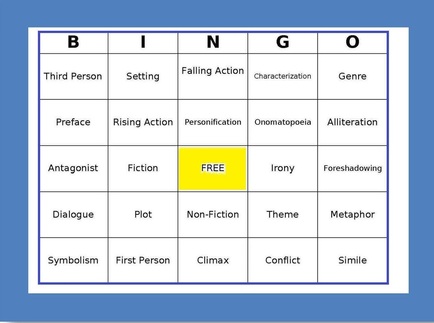 We spent the rest of the class playing Literary Bingo. Students were asked to listen to a definition or example of a literary element and then locate the matching element on their bingo cards. Many of these elements (plot, setting, genre, theme) are ones we have discussed in class or illustrated with class project work. However, several terms were more challenging and new to the students. It was a fun and relaxing way to remind the students of these common literary terms. I've provided the list of terms and definitions (HERE) and would encourage all students to look these over. You just never know when another round of literary bingo may strike! The time is nigh for the publication of the last issue of The Mosaic Monthly! What a wonderful journey this has been for me! I hope your students feel as equally fortified by our experience together. Before I review this week's class, here are some deadlines to keep in mind:
Unless your student has a significant writing assignment due for the paper next week, they should plan to read these pieces aloud on Monday, January 14. From these pieces, I will select a few articles to appear in our last issue. The students normally vote, but in this instance, it will be Editor-in-Chief's choice. There are some students who may need additional time to complete this assignment since they may not have begun their work for Issue III. We went around the room on Monday and clarified everyone's assignment(s), so they should know. Please feel free to ask, however, should anything remain unclear. The Next Steps We have covered so much this semester in terms of the different types of writing found in newspapers today. The students have done a great job of understanding and expressing these differences. Our main challenges lie in choosing topics and pushing ourselves to write more than we think we are capable of. To that end, we engaged in an interesting timed writing exercise on Monday that required students to make a list of objects important to them and then to choose the foremost object they believed they could write a news article on. After writing for five minutes without stopping, we broke into small groups of 2-3. The idea was to read our writing to our partner(s) and for our partner(s) to then give us as much feedback as possible in 2 minutes, without stopping. After receiving feedback, we revised and/or wrote on our topic for another five minutes, switched partners and then repeated the feedback process. The students all agreed it was easier to write than give feedback! We used this opportunity to understand that writing is a process! Publishable writing may need several revisions before it is complete; part of the revision process includes talking about our writing. Next week we will continue our on-going discussions of what makes a good news story and prepare for our last layout session on Monday the 21st. Please feel free to contact me if I can help your student in any way! It's been awhile since we were last together, so I will take a moment to up-date everyone on our last class of 2012. 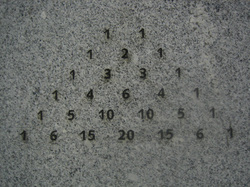 Before the break, we re-visited the ever popular topic of paradoxes, but this time we spent more time defining the meaning of a true paradox (a logical statement that leads to a contradiction) and identifying them. It's more difficult than it seems to distinguish a paradox from a fallacy! We also broke up our paradox discussions with three hands-on puzzles: spatial thinking and reasoning, a Christmas cryptograph (de-coding) and a tangram-type challenge. We ended the day with an intro to Pascal's Triangle, which allowed us to stretch our mathematical muscles and discover patterns hidden in the triangle -- the counting numbers, the triangular numbers, the Sierpinksi Triangle, the powers of 2, the exponents of 11, the Fibonacci Sequence, and last but certainly not least, symmetry! This class provided us with a nice sampling of many of the types of problems we have covered this semester and introduced some new material with Pascal's Triangle. For more information on these triangular patterns, click on any of the hyperlinks in the text above. We use curriculum in part from Art of Inquiry, LLC. Moon Bound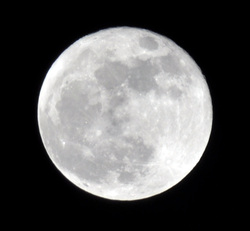 Today's class took us away from paradoxes and brain teasers and landed us on the moon! After a briefing on some of the most basic of the moon's characteristics, students received a worksheet that required them to rank the importance of 15 items that survived a spaceship crash-landing on the moon. These items will assist the survivors of the space craft in reaching the mother ship on the lighted side of the moon. I asked that the students take a minimum of 10 minutes to complete this task, which is outside of our normal comfort zone! We are doing much better at taking our time to think through things thoughtfully and carefully, and most students used all of the ten minutes allotted. Without discussing the "answers," we next divided into three groups of three and filled out another blank sheet. This time, the students were challenged to arrive at a consensus with their teammates before deciding on a ranking AND write down the rationale for their decisions (new vocabulary words for the day: rationale and consensus building!). I was very pleased that the groups took all of the allotted thirty minutes to discuss and debate amongst their teammates. The last phase of the exercise had us forming one large group and devising a methodology to arrive at one answer for each item that the entire group could agree upon. We found ourselves deep in heated discussions, and will have to finish next week! At the end of the exercise next week, we will reveal the "answers" according to NASA, and individual responses will be scored as well as the small group answers. These will be compared with how we fared as one large group, answering the ultimate question: Is consensus building more effective than an individual making decisions on his or her own, or vise versa? Personally, I am anxious to know the results, so stay tuned for the up-date next week. Since we didn't finish the exercise, there is no homework this week. Three more classes and we will turn your creative thinkers out into the world. :>) 2012 Creative Thinking Contest  Students split into teams of two this week and were given six challenging problems to solve in class. The problems covered a wide range of creative and critical thinking areas - basic arithmatic, pattern recognition, logic, lateral thinking, geometry, riddles, creative reasoning, and picture puzzles. My hope was to challenge students to stretch their thinking across the many areas we have tapped into this semester in class. And the stakes were certainly high, as students were vying not only for the title of contest "Winner", but also for the winning prize of...holiday chocolates! (: It was interesting to note the varying approaches taken by each team. Some teams took the "divide and conquer" approach and split the problems between the two teammates, with each member essentially working independently. Other teams adopted a more unified approach, working through each problem together, brainstorming various approaches and possible solutions until they reached a consensus on the final answer. All of the teams worked very hard and completed nearly every problem in the time allotted. Congratulations to Michael and Charlie, the "Winners" of our Creative Thinking Contest! (And thank you both for sharing your sweet prize with the rest of the class)! And...No Homework!
Presenting: The Life of Ben! 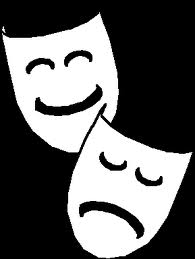 We continued our discussion of the life and contributions of Benjamin Franklin with a readers theater performance in class. Unlike traditional theatre, the emphasis in readers theater is mainly on oral expression of the part, with no use of props, costumes or scenery. Students had not seen the script prior to class, which made their interpretation and reading all the more impromptu and fun! Once one student decided to adopt a British accent for their character, several others joined in, and soon Ben himself had taken on an impressive British lilt! The script took us on a journey through Ben's early years in Boston as an apprentice in his brother James' print shop, to his growth in Philadelphia as an inventor, scientist, entrepreneur and public servant, and finally on to his years in England and France, where he worked as an ambassador on behalf of the colonies for an independent America. The summary of Franklin's life provided in the script will hopefully reinforce the knowledge that students have gained from reading Amos' humorous take on Ben's tremendous contributions to our society. Next Book Selection... 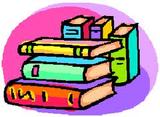 We will wrap up our discussion of Ben and Me when class meets again after the holiday break (Jan 7). I have asked students to come to class with at least one book suggestion, as we will be voting to decide on our final book of the semester. Here are the guidelines I have provided the students:
Wishing all of our students and their families a very Merry Christmas and happy New Year! See you all again in 2013!
Congratulations to our students on meeting another publication deadline. Issue II of The Mosaic Monthly was distributed today and we hope you enjoy reading all of the articles and sections. We are looking forward to producing our final issue, which will be published on our last day of journalism class -- January 28, 2013. Today, we took some time to understand photojournalism -- the art of story telling through photos. After going over the elements of a good story and a good photograph, we divided into two teams and used a random assortment of photos to tell a story. We enjoyed trying to guess the "story behind the photos" of the opposing team. I handed out a "Photo Essay Assignment" sheet that describes the Christmas break homework (see below). I think the students will have a lot of fun with this. As promised, here is a link to some photo essays they can study to better understand the concept. Students should use a stand-alone camera (no phones) if it is available to them. If not, a phone camera would be acceptable. I handed out poster boards to those students that wanted them. We used the last 15 minutes of class to practice taking photographs that played with different forms of light (natural lighting, flash, creating silhouettes). We shared our opinions on which photos were better and why. A couple of students tried their hand at photography and incorporated the elements of varied perspective, varied distances, angles, changes in lighting, and emotion. Nice work! Crack that Code! 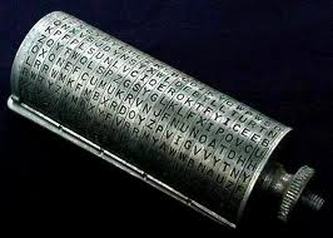 Jefferson's disk cipher Jefferson's disk cipher This week in class we continued the theme of looking for patterns in numbers. Students were introduced to several methods for encrypting and decoding messages using ciphers. We looked at Frequency Analysis - the process by which the frequency of a letter in an encoded message is compared with the frequency of letters in English words. The letters that occur most frequently in the ciphertext will likely correspond to the letters that occur most frequently in English words. Students worked together in class using this method to decode a message from William Shakespeare’s play Julius Caesar. 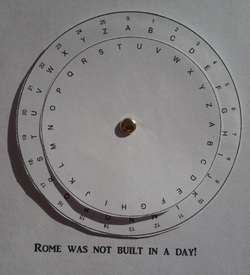 Next, we looked at a method of encryption where each letter is replaced with a letter a specified distance ahead in the alphabet. Such a system is known as a Caesar cipher because Julius Caesar is thought to have used this method to communicate with officers in the Roman army. When sending a message, Caesar would inform his generals what the shift was, so they would be the only ones who could read the encrypted message. Students created their own Caesar Cipher Wheels and worked on encrypting and decoding messages. We agreed that "substitution ciphers" like the Caesar cipher which have a one-to-one correspondence can be fairly easy to crack. But what if we created a cipher with a one-to-many letter correspondence? These "polyalphabetic ciphers" pose more decoding difficulty than a simple substitution cipher. Instead of one shifted alphabet being used, multiple shifted alphabets are used, based on a keyword. One such example is the Vigenere cipher shown HERE. For homework this week, I provided students with the fun and challenging problem of "The Dancing Code Men". These codes are taken from the Sherlock Holmes’ mystery The Adventure of the Dancing Men by Sir Arthur Conan Doyle. Students should use their decoding skills to crack the code and reveal all six encrypted messages. For those interested in reading the entire story, you may find it HERE (though, it's not necessary to solve the problem). Have fun! (: The cipher lesson was created using resources from NCTM Illuminations.
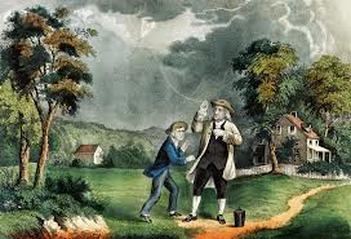 This week in class our discussion focused on Chapters 5 through 9, where Ben (or was it Amos?) performs the famous kite experiment and proves that lightning is in fact - electricity! We took this opportunity to do a little experimenting ourselves. Students learned that electricity is a form of energy caused by charged electrons in an atom. They learned the difference between static electricity (an unmoving, build-up of charged electrons) and current electricity (the steady flow of electrons along a path). 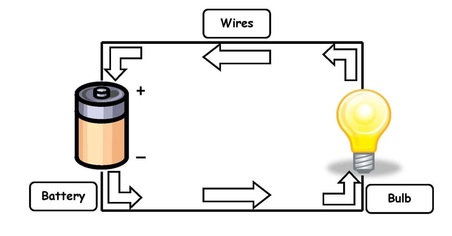 Students then used batteries and aluminum foil strips to create a closed circuit of electricity to light a bulb. See if they can repeat this successfully at home! It took several tries, making sure the circuits were complete and set up properly, with the aluminum foil strips in contact with the positive and negative ends of the battery. We then spent a few minutes playing with Snap Circuits - an engaging, educational toy that allows you to build electrical circuits to light bulbs, trigger alarms and signals, and a whole host of other fun, creative experiments with electricity. You can find out more about Snap Circuit sets HERE. We also enjoyed reading and hearing each others fables, which the students had prepared at home last week. They did a great job of creatively writing pieces that illustrate some of Benjamin Franklin's famous maxims from the book, including "Waste not, want not" and "Early to bed, early to rise, makes a man healthy, wealthy, and wise."
Next week in class we will wrap up our discussion of Ben and Me with a Readers Theater production that summarizes Ben's life and accomplishments. See you all there! This week we took some time to review some of our thoughts that we wrote down on the first day of class nearly three months ago! As we head into our last five classes (unbelievably!) it is my hope that your students will carry their newly found creative thinking skills beyond the classroom and into their everyday lives. On Monday we wrestled with seemingly impossible problems and experienced some optical illusions. Kids love optical illusions and we took a bit of a detour to discuss how and why they happen. When our brain takes information from our eyes and translates it into a picture that is not in check with reality, how do we know what reality truly is? We decided that we rely on all of our senses to help us distinguish what is real. For "play at home" they are to write the word "Teach" horizontally on an 8 1/2 x 11 piece of paper and put a mirror beneath the words to see if they can obtain the same effect we experienced in the classroom. Is it the word itself or the design of the font that created the illusion we saw? We grappled with three hands-on problems in class and while one was quite easy, the other two were only solved after much discussion and playing with the problem. This is exactly what we are trying to achieve. Breaking through the frustration when you don't immediately know the answer and taking time to explore many answers is the ultimate goal of this class. It is my sincere hope that your students will apply these skills to other areas of study, whether it be math, or science, or writing!
I handed out seven riddles that your students should try to crack before Monday. Answers will be shared then. For more illusions that kids will enjoy, click HERE. We use curriculum in part from Art of Inquiry, LLC. |
Categories
All
Archives
May 2016
|

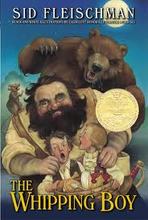
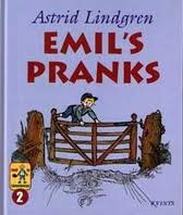

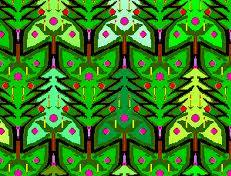
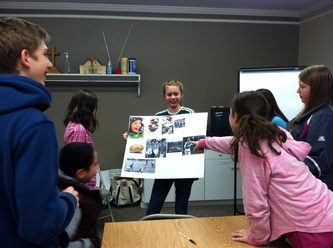
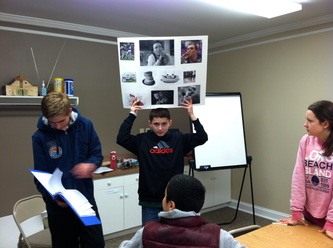
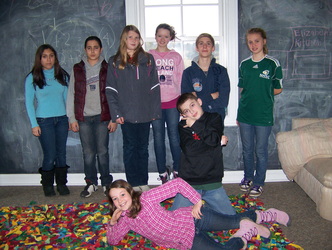
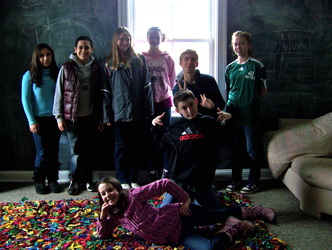
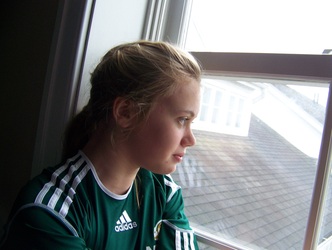
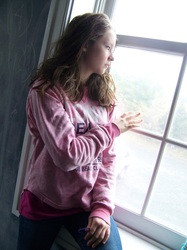

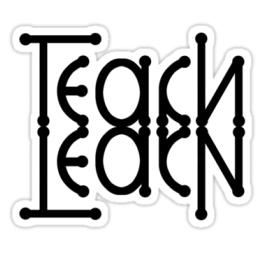
 RSS Feed
RSS Feed